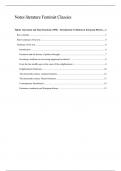Summary
Summary: Tjitske Akkerman and Siep Stuurman (1998) – Introduction: Feminism in European History
- Course
- Institution
A list of key concepts, a short summary and a comprehensive summary of the article: Akkerman, Tjitske & Siep Stuurman, 'Introduction: Feminism in European History' in, idem (eds) Perspectives on Feminist Political Thought in European History, London/New York: 1998, pp. 1-33.
[Show more]



